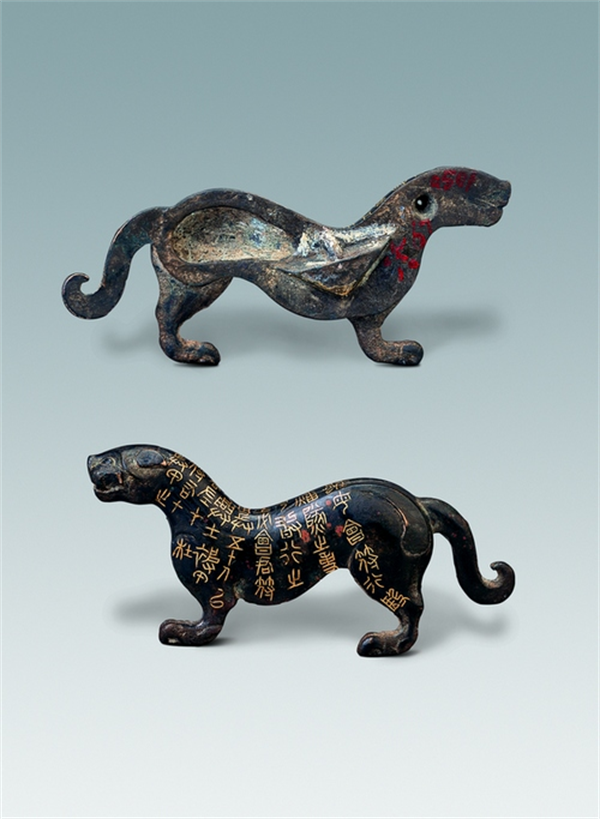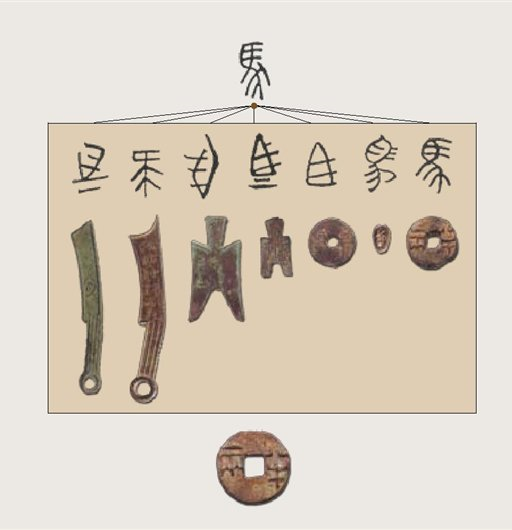The Early Political System
Since the Spring and Autumn Period and the Warring States Period, many politicians, thinkers and officials engaged in theoretical studies cherished a dream of unifying the entire nation. This dream finally came true in 221BC when Ying Zheng, the king of Qin State unified the nation. Beside this unprecedented political exploit, the ruler also established the Emperor Ruling System, Official Ranking System with three Councilors of State and nine Ministers and the System of Prefectures and Counties, which laid the basis for the upcoming centralized political system and were of far-reaching influence upon the Chinese civilization.

Decree with the inscription about Emperor Qin Shihuang setting the Emperor title in the 26th year of his reign and unification about metrology
From the Shang Dynasty to the Warring States Period, the highest ruler was generally called the King. After Qin unified China, the King of Qin, Ying Zheng, felt that the title of King was incompatible with his political exploits and his deserved status. He therefore turned the two holy characters “huang” and “di” into a compound word as his title to show that his exploits were greater than all the famous kings and rulers before him who were jointly called “three huang and five di”. Meanwhile, he abolished the regulations for posthumous titles and called himself “Shi Huangdi” (literally the First Emperor) and thus his successor being called Emperor the Second, the Third and to the infinity. To distinguish between the emperor and the common people, regulations for exclusive use by the emperor were promulgated, by which the imperial decree is addressed “zhi” or “zhao” and no name of the emperor can be written in the decree. The emperor called himself “zhen” and his seal was called “xi”. Before Emperor Qin Shihuang, the character “zhen” was a common character meaning “I” and “xi” could also be used to refer to anyone’s seal. Under the Emperor System, the emperor enjoys supreme power and all governmental officials are appointed by the emperor and should do as the emperor requires. Under such a system, the army is also controlled by the emperor and deployment of more than 50 soldiers requires the tiger-shaped tally from the emperor and would otherwise be illicit.

The earliest existing tiger-shaped tally for military deployment of Qin
The Official Ranking System with three State Councilors and nine Ministers was compatible with the Emperor System, which was in nature the extension of the central regime. Three Councilors refer to cheng xiang (the prime minister), tai wei (the supreme official in charge of military affairs) and yu shi da fu (the supreme official supervising officials of various ranks). Among these three councilors, the prime minister takes the highest position and tops the official ranks. Nine Ministers refer to the major officials and military officers of the central government including feng chang, lang zhong ling, wei wei, tai pu, ting wei, dian ke, zong zheng, zhi su nei shi, shao fu etc. These ministers have their specific responsibilities but all take orders from the emperor.

Diagram showing the government structure of the Qin Dynasty
The system of prefectures and counties is an administrative system and official system for local governments. After the unification of the entire nation, the system of enfeoffment was totally abolished and the system of prefectures and counties previously adopted in Qin State was adopted throughout the nation. The country was initially divided into 36 prefectures and gradually new prefectures were established along the frontiers, which drove the total number to 46. The prefectures were subdivided into counties. The highest official in the prefecture was called jun shou, who was responsible for the administration of the prefecture. Apart from jun shou, there were jun wei in charge of military affairs and jian yu shi appointed by the central government to supervise the local officials. In counties with more than 10,000 households, a county magistrate called xian ling was appointed and for counties with less than 10,000 households a head was pointed. The county magistrate was responsible for the county’s local affairs, xian cheng for official documents and legal affairs and xian wei for military affairs in the county. All these local officials were directly appointed by the emperor.
The three-level official system of “Emperor— Minister—Prefecture and Counties” initiated in the Qin Dynasty was pursued until the Qing Dynasty with only minor changes of official titles in different dynasties, which explains why Tan Sitong, a great reformer in late the Qing Dynasty, uttered the famous saying that “the political system of China over the past 2,000 years was nothing but the political system of the Qin Dynasty”. Mao Zedong, the first Chairman of P. R. China, also put down the famous line in his poem “For thousand years the Qin System failed not”.
Apart from the centralized political system, the Qin Dynasty also conducted a series of unifying measures such as unifying of the writing system, metrology, currency, laws and regulations, which were of far-reaching influence upon the successive generations.
Chinese characters originated quite early in China and had well-developed till the Warring States Period. But due to long-term splitting of the country, one character was even written differently in different states and some characters were even written differently in one state, which greatly hindered the promulgation of political orders and cultural communication. In the first year of the Qin Dynasty, therefore, Emperor Qin Shihuang ordered the unification of the writing system, regulating that xianzhuan, the small seal script be the unified writing style. Henceforward, xianzhuan, became the official standard writing system, which marked the first standardization of writing system in China. To popularize the unified writing system, Emperor Qin Shihuang appointed Li Si, Zhao Gao and Hu Wujing to compile the popular literary works in xiaozhuan, to serve as the copybook for calligraphy. The unification of writing system in the Qin Dynasty was the first successful large-scale reform of writing system launched by the government. It featured standardizing of characters and simplifying of the characters and it complied with the requirements of the society. From then on, unified and standardized characters were adopted nationwide, which contributed greatly to the social and economic advancement of China.

Diagram showing the unification of writing system and currency in the Qin Dynasty
Metrology refers to the measurement of length, capacity and weight. Before the nation was unified in the Qin Dynasty, metrology varied in different regions, which stalled the economic development, cultural communication and the unified cause of China. Shortly after unification, Emperor Qin Shihuang mandated the unification of metrology, requiring measurements in various regions to be standardized. In terms of the measurement of length, for instance, the basic units were chi and bu with one chi equaling to six bu. The basic weight units were zhu, jin, jun, dan etc. Capacity was measured by sheng and dou. Earlier unification efforts were made by Shang Yang who, in his reforms, regulated the basic fang sheng, which was actually the basic standard vessel at that time. What is noticeable is that Emperor Qin Shihuang’s rescript was carved later on the standardization vessels adopted before the national unification. On the bottom of the standardization container fang sheng, for example, there are carved rescript by Emperor Qin Shihuang. In 1972 an oval-shaped vessel was unearthed in Liquan County, Shaanxi Province. On the outer surface are two rescripts by Emperor Qin Shihuang and Emperor the Second. These two rescripts on one single vessel embody the Qin Empire’s emphasis on the standardization of metrology, which makes the vessel all the more valuable. The Gaonu Bronze dan quan in Gaoyao Village, Xi’an, is a very important measurement vessel. Gaonu was the jurisdiction area of Shangjun Prefecture in the Qin Dynasty and it was located next to the recent Yan’an City, Shaanxi Province. dan is one major measurement unit of the Qin and Han dynasties, which equals to 120 jin. quan is sort of measurement unit like the weights. On the object there are rescripts saying it was issued by the central government to standardize weight measurement and would be recalled regularly for precision. After precision, it would be reissued with official seals from the central government. The seals on it show that it was recalled twice but was not issued again before the Qin Dynasty was subverted.

The oval-shaped measurement vessel of the Qin Dynasty Gaonu Bronze dan quan

Currency took different shapes and sizes in different states in the Warring States Period, which led to the inconsistence between currency units and difficulty in currency exchange. After the subversion of the other six states, Qin abolished all the other currencies used by the six states and divided all currencies into two categories: the gold currency and the copper currency. Gold were counted by yi, one yi equaling to 20 liang (tael); each copper coin weighed half liang and took the circular shape with a square hole in the middle, which reflected the Chinese traditional concept of “the sky being round and the earth square”. From then on, it became the basic design for coins for the succeeding 2,000 years. The unification of currency made it easier for currency exchange and therefore brought convenience for trade and commerce, which greatly promoted the social advancement in ancient China.

A coin of half liang in the Qin Dynasty
The unification measures taken by the Qin Empire and the state unification not only greatly influenced Chinese civilization but also made China a familiar name to the world. Qin was therefore regarded by many westerners as the nickname for China, which is illustrated by many scholars’ belief that the English word “China” was possibly the transliteration of the Chinese character Qin (pronounced chin). Other names used in some historic records of western countries also contain the sound of qin, which further testifies that the Chinese civilization began to draw attention from the western world from the Qin Dynasty.


